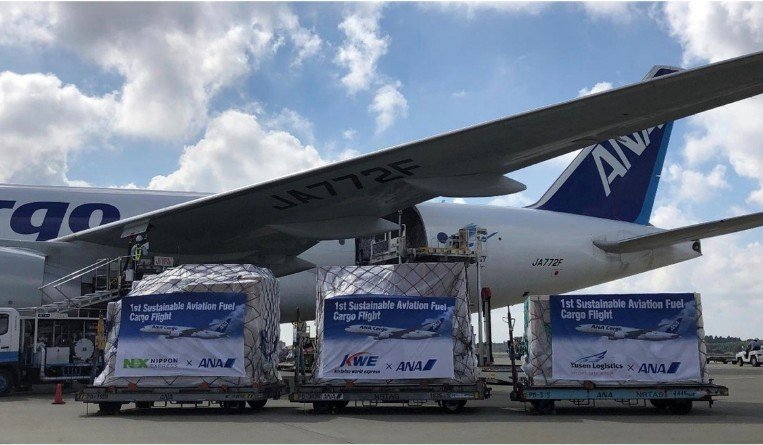The cargo division of All Nippon Airways has launched the airline’s SAF Flight Initiative, a new dedicated programme designed to reduce CO2 emissions, the carrier told reporters at IATA’s World Cargo Symposium in Dublin.
The move is one of the early moves in monetizing the sustainability agenda, as well as shining a spotlight on the difficulties of that agenda.
The initiative is also the first commercial use of sustainable aviation fuels (SAF) by an Asia-based carrier, and follows on from its first working flight using SAF, which took place on September 29 from Tokyo Narita to Frankfurt.
The fuel blend on that flight included 36.94% SAF, one of the highest percentages to date, Sadami Sugimoto, vice president for cargo marketing and services, Europe, Middle East and Africa, told reporters in the sidelines of the symposium.
However, the SAF had not been produced locally and had to be brought to Japan by sea from northern Europe. Typically, SAF is mixed with kerosene for use.
The programme is the latest effort by ANA to decrease its carbon footprint and adhere to the guidelines established by the United Nations Sustainable Development Goals (SDGs), as well as to meet ANA Group’s environmental commitments, which were announced earlier this year.
Nippon Express, Kintetsu World Express and Yusen Logistics will participate in the SAF Flight Initiative, a sign of the increasing appeal of SAF in the air cargo industry.
“For Yusen Logistics this is one of the initiatives we want to embrace. We will be rolling out more initiatives,” Rotterdam-based Saskia van Pelt, air freight forwarding director (Europe) at Yusen Airfreight, told reporters.
The scheme works by giving corporate customers the option to choose less-polluting SAFs fuels. However, initial take up has been limited as operators wait for SAF options to become more widely available.
While Yusen Kintetsu and Nippon Express bought fuel for the inaugural flight, at the moment, they cannot buy any more simply because there isn’t any to buy.
“As of today, we don’t have any corporate customers who are buying it,” Sugimoto told reporters. “We are still struggling to get more.” Sugimoto added that the problem is that SAF can’t be made quickly enough or in large enough quantities to guarantee smooth supplies.
Matching the problem of erratic supply is SAF’s equally volatile pricing. “Sometimes, [it’s] two times [the price of conventional fuel,] sometimes five times,” said Sugimoto.
This mixture of high price and scarcity does not seem to deter customers. Sugimoto and van Pelt both reported bite-your-hand-off levels of interest in buying what is not yet there, although the desire for SAF remains primarily a European phenomenon at the moment. “Shippers are already willing to pay,” said Sugimoto.
Van Pelt added: “Do we have enough SAF? No. Do we have enough customers who are willing to pay? Yes.”
Van Pelt noted that not only do the forwarders themselves want to reduce their own carbon footprint, but their clients are just as keen, if not more so, to do the same. “We do see, particularly in the European region, a number of customers asking us not just for SAF but what we are doing by way of carbon calculation,” said van Pelt. She said this is becoming a requirement on invoices and even as far down as airway bills.
ANA is keen to reduce its carbon footprint for its own reasons, as well as providing a service its customers are willing to pay for. The airline wants to go carbon free, and quickly, in order to not have to do carbon offsetting and other measures firms use to be carbon neutral, which many believe will be a requirement in the future. “Our goal is not to rely on carbon trading [and to truly cut carbon out,]” Sugimoto said.
The current situation is, however, frustrating for ANA, who plans a rollout across the airline and wants a second, a third and a fourth SAF flight as a starting point to encouraging customers to reduce their own carbon footprints. What would help them longer-term are facilities at airports to store SAF. “We are working with airports and other airlines to push the Japanese government,” said Sugimoto.
Hydrogen is also a longer-term possible fuel, but it needs a technological breakthrough before it can be commercialized, he added, pointing out that hydrogen might not help the air cargo industry as much as it could surface transportation.
Michael Mackey



